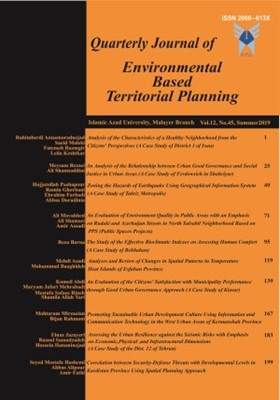Assessing the Urban Resilience against the Seismic Risks with Emphasis on Economic, Physical, and Infrastructural Dimensions (A Case Study of the Dist. 12 of Tehran)
Subject Areas :Elnaz Jazayeri 1 , Rasool Samadzadeh 2 * , Hossein Hataminejad 3
1 - Department of Geography, Islamic Azad University, Ardabil Branch, Ardabil, Iran
2 - Department of Geography, Islamic Azad University, Ardabil Branch, Ardabil, Iran
3 - Associate professor, Department of Geography, University of Tehran, Tehran
Keywords: Economic, Earthquake, Keywords: resilience, Dist. 12, physical-infrastructural,
Abstract :
The present research aimed to assess the quantity of indicators of economic and physical-infrastructural aspects of resilience in Dist. 12 of Tehran against earthquake which has been assessed according to the optimal rate at the universal level. In order to define the optimal rate in the research, the numerical value of each index in the regions throughout the world where multiple crises have occurred (such as Japan and California) have been considered as the optimal level of resilience for each factor. The method of research in this study is descriptive-analytical. Therefore, after doing the theoretical and empirical review of literature about the resilience, the researchers presented a conceptual model for assessing the quantity of resilience throughout the region. Giving the definitions of the criteria and factors at the economic and physical-infrastructural levels, the researchers compared the quantity of resilience against earthquake at its optimal level. The results of the findings indicated that among the economic indicators, three criteria of the type of business, the scale of business and the level of employment which had been examined were all below the optimal level. Among the physical-infrastructural indices, all indices were below the optimal level, and among them, the density index constructed with a distance of 94% from the optimal level (1) had the highest difference with the optimal level.
1- بربریان س، قریشی م، ارژنگ ر، اشجعی م، 1374-1364، پژوهش و بررسی ژرف زمینساخت و خطر زمینلرزه در گستره تهران و پیرامون " گزارش شماره 56" سازمان زمینشناسی کشور، 26.
2- پور طاهری، م، سجاسی قیلداری، ح، صادقلو، ط، 1390، ارزیابی تطبیقی روشهای رتبهبندی تکنیک مخاطرات طبیعی در مناطق روستایی، (مطالعه موردی استان زنجان)، مجله پژوهشهای روستایی، 2، 3: 60.
3- خاک پور ب، حیاتی س، کاظمی بی نیاز م، ربانی ابوالفضلی غ، 1392، مقایسه تطبیقی/ تحلیلی میزان آسیب پذیری بافتهای شهری در برابر زلزله با استفاده از مدلهای تحلیل سلسله مراتبی و فازی (نمونه موردی شهر لامرد) فصلنامه آمایش محیط، شماره 22 ، 21.
4- داداش پور، ه، عادلی ز، سنجش ظرفیتهای تاب آوری در مجموعه شهری قزوین، مجله مدیریت بحران، 4، 8: 26.
5- رحمتی ص، گندمکار الف، خوشکلام پور الف، 1393، ارزیابی متغیرهای تأثیر گذار بر آسیب پذیری مساکن شهری در برابر زلزله (مطالعه موردی شهر بروجرد)، فصلنامه آمایش محیط، شماره 24، 85 .
6- سرور ه، کاشانی اصل الف، 1395، ارزیابی آسیب پذیری شهر اهر در برابر بحران زلزله، فصلنامه آمایش محیط شماره 34، 87 .
7- صالحی، الف، آقابابایی ،م ، سرمدی ه، 1390، بررسی میزان تاب آوری محیطی با استفاده از مدل شبکه علیت، مجله محیط شناشی شماره 59: 35.
8- طرح تفصیلی منطقه 12 تهران، 1385، گزارش شماره 1 وضع موجود منطقه 12 تهران، مهندسین مشاور باوند، 35.
9- ریز پهنه بندی شهر تهران، 2004 گزارش گروه مطالعاتی جایکا، ژاپن، 41.
10- گاسپارینی پ، مانفردی، گ، آسپرونه، د، 2016، تاب آوری و پایداری در مقابل بلایای طبیعی (چالشی برای شهرهای آینده) مترجم حسین حاتمی نژاد و مرتضی نصرتی هشی، انتشارات آراد، تهران: 16.
11- محمدی سرین دیزج، م ، احدنژاد روشتی م، 1395، ارزیابی میزان تاب آوری کالبدی شهری در برابر مخاطره زلزله مطالعه موردی شهر زنجان، مجله تحلیل فضایی مخاطرات محیطی، 3، 1: 3.
12- مرکز لرزه نگاری ژئوفیزیک دانشگاه تهران، 1393، 42.
13- مرکز آمار ایران، 1390، سرشماری نفوذ و مسکن.
14- Ainuddin, S., Routray, J. (2012). Community resilience framework for an earthquake prone area in Baluchistan. International Journal of Disaster Risk Reduction, 2, 25-36.
15- Godschalk, D. (2003). Urban Hazard Mitigation: Creating Resilient Cities. Natural Hazards Review, 4 (3), 136-143.
16- Holling, C. S. (1973). Resilience and Stability of Ecological Systems. Annual Review of Ecology and Systematic, 4, 1-23.
17- Mayunga, J.S‚ (2007) ‚ Understanding and Applying the Concept of Community Disaster Resilience: A Capital-based Approach, Draft paper prepared for the Summer Academy for Social Vulnerability and Resilience Building, July 22-28, Munich, Germany
18- Maru, Y. T. (2010). Resilient Regions: Clarity of Concepts and Challenges to Systemic Measurement. CSIRO Sustainable Ecosystems, 4 (1), 26-40.
19- Mileti, D. (1999). Disasters by Design: A Reassessment of Natural Hazards in the United States. National Academies Press
20- Morrow-Howell, N.; O’Neill, G.; Greenfield, J. C. 2011. Civic Engagement: Policies and Programs to Support a Resilient Aging Society. Resilience in Aging, Springer New York,147-162.
21- Norris, F. H. et al. (2008). Community Resilience as a Metaphor, Theory, Set of Capacities and Strategy for Disaster. American Journal of Community Psychology, 41 (1 & 2), 127-150
22- United States Census Bureau (2013). “United States Census, Bureau. available at http://www.census.gov/. Accessed 23 August 2014
23- Usamah‚ M., Handmer‚ J., Mitchell‚ D., Ahmed‚ I. (2014)‚ Can the vulnerable be resilient? Co-existence of vulnerability and disaster resilience: Informal settlements in the Philippines
_||_
